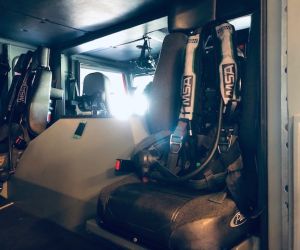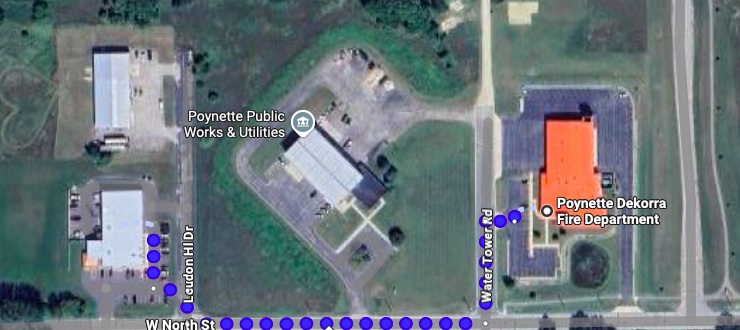Ride of the Velcroed

If it’s winter toss the jacket, if it’s summer drop the pants after you kick the shoes off. Drop keys wallet and phone in rescue helmet on locker. If winter, add sock layer and maybe vest. Grab boots pants suspender combo from bottom of locker and place on floor. Insert legs. Don’t fall. Pull up pants. Pull up suspenders. Clasp belt. Grab hood from jacket pocket and pull over head. Radio next, double check battery level and pull mic/speaker off strap and throw over left shoulder from rear. Grab ladder hook and clip into belt carabiner. Grab axe and put in axe loop. Chat up anyone nearby on what they know and where we’re going. Rip safety vest off jacket and toss aside. Pull jacket off hanger and throw on without hitting anyone. Zip up. Secure velcro. Pull the radio mic/speaker out from inside the jacket. Tighten neck velcro. Pull down hood. Grab helmet and bottle of water from top of locker. Snickers bar if necessary. Put phone between teeth and get to the rig. Don’t trip or knock anyone over.
Climb in. Set helmet down somewhere you can reach. Put phone and water bottle somewhere. Unclip extrication glove carabiner from jacket loop and toss gloves you are not using somewhere. Pull structural fire gloves off velco loop on jacket and place somewhere you can reach them while buckled into seat. Stuff velco glove strap loop into pocket. Sit down and pull skull cap and safety glasses out of helmet. Put skull cap on and throw safety glasses somewhere without hitting anyone. Right arm through SCBA strap. Left arm through SCBA strap. Cinch straps down. Locate right SCBA waist buckle. Locate left SCBA waist buckle. Buckle and tighten. Arms up, locate left and right SCBA chest straps and … try not to swear because the straps are too tight … and buckle. Grab nearest mask and put loop strap over head, but not interfering with hood. At all times, listen for radio traffic or officer instructions. Locate seat belt and click it to stop that annoying alarm from going off. Pull i.d. tags off your helmet and hand them forward to the officer. Help your fellow back-seaters with the cluster of straps in tight quarters. Pre-hydrate with the bottle of water. Get your helmet on your lap, with your structural fire gloves in it. Candy bar, if some distance from a meal. Be prepared to jump out with your helmet and gloves on, ready to go, with the radio on the right channel. Grab the TIC or a box light if you are not on nozzle. Along with the axe and Halligan. Along the way, smile, offer an observation or just watch the world go by backwards. Lights flashing. Inner calm. Happiness. Sirens wailing. Maybe hum a few bars of Ride of the Valkyries.
Or sing some Gaslight Anthem in your head, synching up the song's end with the ride's end.
There are three things you want to avoid. Top on the list is any uncovered skin. On you or anyone else. Check your partner, and have your partner check you.
This may seem odd but, tied for avoiding burning flesh is not being 100% ready when the rig arrives on scene. No joke. If you are not fully ready to go when the rig stops at the scene of the fire, just stay inside and hide. As the rest of the crew heads toward the problem, walk home, and do not ever come back. Because the people waiting for the fire department to arrive do not want to see you fumbling with your regulator … or anything else.
One last thing to avoid is getting clotheslined by the seat belt on the way out the door. Which can happen even if you do the whole sequence perfectly, and the seat belt just catches on something as it retracts. Use your arm to guide the belt away from all of the stuff strapped to your body as it retracts.
Jump out, with enthusiasm and purpose. Get to work.
Gearing up on the go is part of the deal. There should be a whole class on it, but there wasn’t. You have to figure it out yourself. Early on I spent hours over the course of weeks practicing alone while trying to find the sequence which works best for me. Now I can do it in my sleep and sometimes do.
Came in handy Friday when the fire call was not a couple miles or a few minutes away. It was 1,056 feet away, says Google Maps. Not even far enough for a Ramones tune.

Poynette Auto Body (highly recommended) had a water flow alarm, which typically means fire suppression sprinklers are flowing. Or some other problem. But you do not really know the problem until you get there, so you prepare for the worst. Expect fire. Expect victims, goes the saying.
Alan at the wheel, Captain Barger in the officer’s seat, me and FF James (no longer a Probie) in back. The only closer building to the Fire Station is Public Works, just across the street.
Arrive on scene in something under a minute fully ready to go. Do the jump out thing and … no smoke. No people panicking and fleeing. Instead, people perplexed and annoyed. There’s water flowing from the ceiling of a paint booth, but no other evidence of fire.
A fire service truism is we get called when somebody is having a bad day. So, be careful about calling anything anticlimactic. If someone is having less of a bad day than what you jumped out to fix … good. Even if there is no fire, somebody has a problem they cannot solve on their own, and you are there to help.
We promptly shut down the fire sprinkler system and traced the problem to one hidden sprinkler head that … I don’t know* … got a little excited or something. We move some valves back into operation so the rest of the building has fire suppression ready to go, if needed. The sprinkler company gets called to fix the premature suppressor, and Poynette Auto Body gets back to work.
We go back to the station and our non-fire lives too, reversing all those steps at a far more leisurely pace and saying the customary “see you at the next one” goodbye.
And then you go back to work or home or whatever and. Well. Kinda hope for the next one.
___
* Update: Apparently, the paint booth also operates as an oven after the painting is done. It is supposed to stop at 175 degrees. The sprinkler head that went off is supposed to go off at 200 degrees. The combination of hot weather and sprinkler head's location in an enclosed space above the paint booth ceiling is what likely triggered it when the paint booth was in oven mode.

